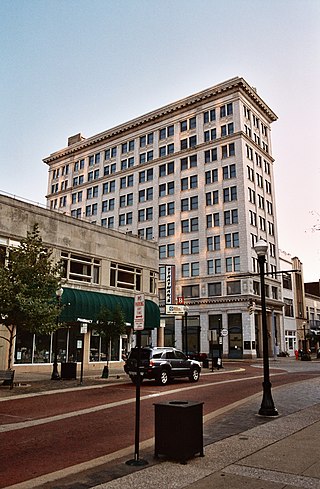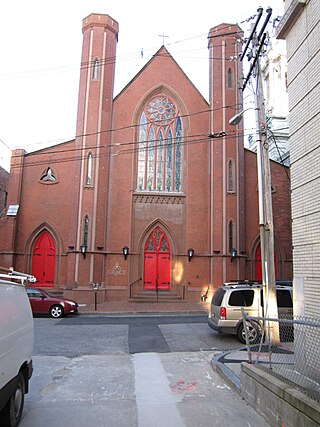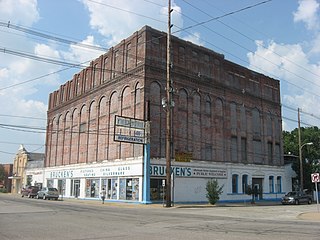
The First Universalist Church is a historic church building on the corner of Pleasant, Elm, and Spring Streets in Auburn, Maine. It was built in 1876 to a design by John Stevens of Boston, Massachusetts, and has been a significant landmark in the city since its construction. It is a fine local example of Gothic Revival architecture executed in brick, and was listed on the National Register of Historic Places in 1979.

Citizens National Bank, since known as the Hilliard-Lyons Building and Kunkel Square, is a building noted for its stone and terracotta facade, located at Fourth and Main Street in downtown Evansville, Indiana. The building is ten stories tall and was the region's first skyscraper. The architect was William Lee Stoddart. It officially opened on Washington's birthday in 1916. In 2011 the building was converted to 46 luxury apartments.

The Orleans County Courthouse Historic District is one of two located in downtown Albion, New York, United States. Centered on Courthouse Square, it includes many significant buildings in the village, such as its post office and churches from seven different denominations, one of which is the tallest structure in the county. Many buildings are the work of local architect William V.N. Barlow, with contributions from Solon Spencer Beman and Andrew Jackson Warner. They run the range of architectural styles from the era in which the district developed, from Federal to Colonial Revival.

The former Chestnut Street Methodist Church is an historic church building at 15 Chestnut Street in Portland, Maine. Built in 1856, it is rare in the city as an early example of Gothic Revival architecture, and is one of the few surviving works of Charles A. Alexander, a popular architect of the period. The building was listed on the National Register of Historic Places in 1977. It now houses a restaurant.

The Masonic Temple in Evansville, Indiana, USA, is a building from 1913. It was designed by the local architects Shopbell & Company in Classical Revival style. The lodge building once hosted three separately chartered Masonic lodges: Evansville Lodge, Reed Lodge and Lessing Lodge. The building measures 72 x 104 feet, with four stories above ground and a basement. The exterior walls of the first two floors are faced with stone and the stories above are trimmed with both stone and terracotta. The interior floors and partitions are supported by steel columns and girders, also following the Roman classic order.

Salem's Baptist Church is a historic Baptist church located at 728 Court Street in downtown Evansville, Indiana. It was built in 1873, and is representative of Prairie School architecture.

American Trust and Savings Bank, also known as the Indiana Bank, is a historic bank building located at Sixth and Main Street in downtown Evansville, Indiana. It is designed by the architectural firm Harris & Shopbell and built in 1904. It is a Beaux-Arts style limestone clad building. It was enlarged in 1913 when two additional floors were added. The bank closed on October 19, 1931, during the Great Depression.

The Hulman Building is a ten-story art deco high rise in downtown Evansville, Indiana. Construction began in 1928 and was completed in 1930 with a brick facade of light yellow. It was the first of several Art Deco buildings to grace Evansville's skyline.

Albion Flats is a housing unit in downtown Evansville, Indiana. It was designed by the architectural firm Shopbell & Company and built in 1911 as part of a trend to reform crowded living conditions for the working class. It was named after Albion Fellows Bacon, a famed advocate of improved public housing standards.

Culver Historic District is a national historic district located at Evansville, Indiana. The neighborhood is all residential, and unlike most of the rest of the city, the lots are not laid out on a grid. Most of the houses are on a lot previously part of the farm owned by Robert Parrett, a native of England who settled in Evansville and built a house near the intersection of Madison Avenue and Parrett Street. Eventually Robert Parrett would become the first Methodist minister in Evansville and helped found Trinity Methodist church, which he served until his death in 1860. His heirs divided up the plat in 1863.

223 Main Street is a historic commercial building located in downtown Evansville, Indiana, United States. It was built in 1910, and is a three-story, Art Nouveau style building.

The H.G. Newman Building is a historic commercial building located in downtown Evansville, Indiana. It was built in 1900, and is a two-story, Late Victorian style brick building. The building features decorative brickwork and parapet, and round arched openings. It was originally built to house a wholesale grocery and farmers' supply.

Siegel's Department Store is a historic commercial building located in downtown Evansville, Indiana. It was built in 1902, and is a two-story, Romanesque Revival style brick building. The building was originally built to house a haberdashery.

Evansville Brewing Company is a historic brewery located in downtown Evansville, Indiana. It was built between 1891 and 1893, and is a four-story, Romanesque Revival style brick building.

Fred Geiger and Sons National Biscuit Company is a historic biscuit factory building located in downtown Evansville, Indiana. It was built in 1894, and is a two-story, brick building. It features decorative brickwork, segmental arched openings, and limestone detailing. It housed Fred Geiger and Sons, a manufacturer for the National Biscuit Company.

St. John's United Church of Christ, originally known as St. John's Evangelical Protestant Church, is a historic United Church of Christ church located in downtown Evansville, Indiana. St. John's Parish Hall was built in 1921, and is a Tudor Revival style brick building.

Zion Evangelical Church is a historic United Church of Christ church located in downtown Evansville, Indiana. It was built in 1855, and is a Gothic Revival style brick church. It features Gothic arched openings and an octagonal steeple.

Auto Hotel Building is a historic parking garage located in downtown Evansville, Indiana. Auto Hotel was built in 1929, and is a four-story, Colonial Revival style brick building.

Lockyear College, also known as Lockyear's Business College, was a historic Business college located in downtown Evansville, Indiana. Originally named Columbian Business College when it opened in 1893 at Fourth and Main streets, the institution became known as Lockyear Business College after Melvin H. Lockyear became in 1897; continuing growth led to the new building on Fifth Street, which was built in 1911, and was a Classical Revival style building.
Hillary Bacon Store, also known as Woolworth's, was a historic commercial building located in downtown Evansville, Indiana. It was designed by the architecture firm Shopbell & Company and built in 1921. It was in Chicago school style architecture. It was destroyed by fire in 1990.

























